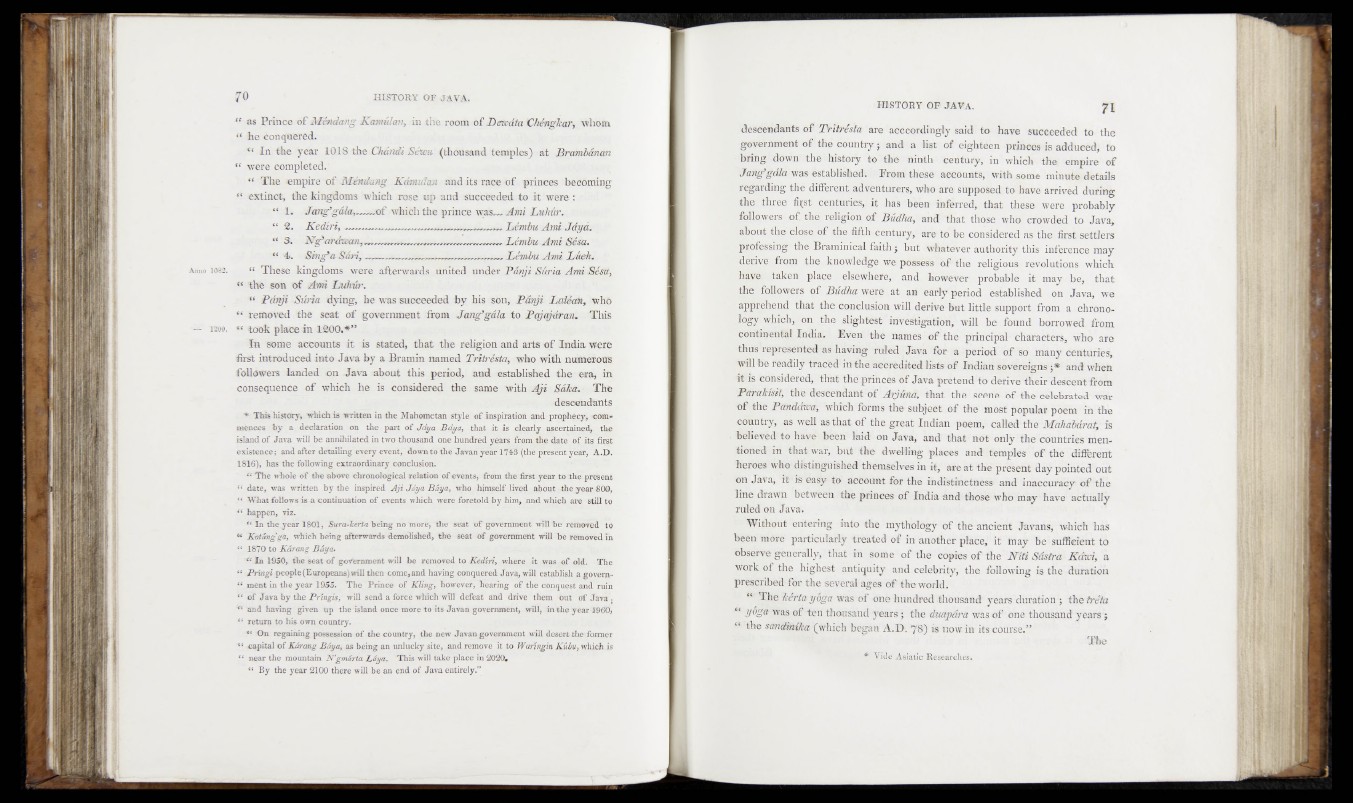
70 HISTORY OF JAVA.
Anno 1082.
?P 1200.
“ as Prince of Mmdatig Kamulan, in the room of JDffwâta Chéngïcar, whom
“ he conqaerèd.
ct in the year 1018 the Ckândi Séwu (thousand temples) at Brambanan
u were completed.'
“ The empire of Méndang Kdmiiîiw and its race o f princes becoming
“ extinct, the kingdoms which rose up and succeeded to it were :
1. Jang’gada,._™of which, the prince was— Ami BuMr. ,
2. Kedîri, __.„..,..,-„,„ -1,1,1 r. v . ,-ftt Xiénibu Ami Jdya.
3. K g’At'duvan,..» ■ » .it»» .Mu.--uj 11 * 1 1-11 1 T.dmht/. Ami Sésa.
4*. Sing’a Sari, .____________Bèmbu Ami Léeh.
“ These kingdoms were afterwards united under Pârtji Séria And Séstt,
P the son of Ami Bidair.
“ Pdrÿi Sw-ia dying, be was succeeded by his son, Pâryi JLailëcm, who
“ removed the seat of government fern Jang’gala to Piÿaÿdiran. This
** took place in i@00.*”
In some accounts it is stated, that the religion and mis o f India were
first introduced into Java by a Braruin named Tntrésta, who with numerous
followers landed on Java about this period, and established the era, ift,
consequence of which he is considered the same with Aji Sâka. The
descendants
* This history, which is written in the Mahometan style of inspiration and prophecy, 'commences
by a declaration on the part of Jdya Bdya, that i t is clearly ascertained, the
island of Java will be annihilated in two thousand one hundred years from the date of its first
existence; and after detailing every event, down to the Javan year 1743 (the preseht ÿe&r, A.D.
1816), has the following extraordinary conclusion.
“ The whole Of the above chronological relation of events, from the first year to the present
“ date, was written by the inspired Aji Jâya Baya, who himself lived about the year 800,
“ What follows is a continuation of events which were foretold b y him, and which are stfil to
“ happen, viz,
** In the year 1801, Sura-Tcerta being no mote; "the seat of government will be removed to
“ Katdng'ga, which being afterwards demolished, the seat of government will be removed in
“ 1870 to Karang Bdya.
“ in 1950, the seat o f government will be removed to Kedîri, where it was o f old. -The
“ Pringi people (Europeans) will then come, and having conquered Java, will establish a govern-
“ ment in the year 1955. T h e Prince of Kling, however, Bearing of the conquest and ruin
“ of Java by the Pringis, will send a force which will defeat and drive them out of Javaand
having given up the island once more to its Javan government, will, in the year 1960,
“ return to his own country.
| | On regaining possession of the country, the new Javan government will desert the former
“ capital o f Karang Bdya, as being an unlucky site, and remove it to Waringin Kubv, which is
“ near the mountain N ’gmdrta Liya. This will take place in 2020.
“ By the year 2100 there will be an end of Java entirely.”
descendants of Tritresta are accordingly said to leave succeeded to the
government of the country ; and a lift of eighteen princes is adduced, to
bring down the history to 'the -ninth century, in which the; empire' of
Jang-gdla was established.' From these accounts, withsome minifto details
regarding the different adventurers, who are supposed to have arrived during
tbfe: fifst centuries,, it has been inferred, that these, were probably
followers of the religion; o£- Budhaf > and that those; who crowded to Java,
Shpnf tfee closer of the fifth eentary;-- are-to^be considered as the first settlers
professing the Braminical faith q hut whatever authority this inference may
derive from the,knowledge we possess of the1 religious,!revolutions which
have taken- place ^ elsewhere, and however probable it may be, that
the^fa'll’owers of Budha were ,at an early period established ;,on Java, we
apprehend that ith©. inclusion will derive but little, support from a chrono-
logy which-,j on the slightest investigation/' will be found borrowed from
continental India. Even the names of the principal characters, who are
tbhslrepresented as having ruled Java for a period o f so many centuries,
%riilbte readily traefed- iri ftie accredited lists of Indian sovereigns ;* and when
■Kris Considered, that the princes of java pretend to derive their descent from
ParaMsit, the descendant of Arjund, that the scene of the celebrated war
of 'tlie Pandcewct, which forms the subject o f the most popular poem in the
,||intry, as well as that of the great Indian poem, eafed'ffi© Mahabdrat, ft
believed to have been laid on Java, and that not only the countries mentioned'
in that war, but the dwelling places and temples o f the different
heroes who distinguished themselves in it, are at the present day pointed out
on Java, it Is easy» to aeeonnt fee the indistinctness and inaccuracy of'the
line drawn between the princes of India and those who may‘have' actually
ruled on Java!, v
Without entering into the mythology of the ancient Javans, which has
been more particularly treated of in another place, it in ay fee-sufficient to
observe generally, that in some o f the copies o f the N iti Sdstra K M , a
vtork of the highest antiquity and celebrity, the following is the duration
prescribed for the several ages of the world.
“ The kSrtaySga was of one hundred thousand years duration ; the treta
y®g® was of ten thousand years; the duapSra was o f one thousand years;
“ the smdiaika (which began A.D. 78) is now in its course.”
The
* Vide Asiatic Researches.